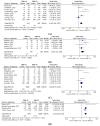COVID-19 in Pregnancy: Influence of Body Weight and Nutritional Status on Maternal and Pregnancy Outcomes-A Review of Literature and Meta-Analysis
- PMID: 36839410
- PMCID: PMC9962478
- DOI: 10.3390/nu15041052
COVID-19 in Pregnancy: Influence of Body Weight and Nutritional Status on Maternal and Pregnancy Outcomes-A Review of Literature and Meta-Analysis
Abstract
In the last two and a half years, COVID-19 has been one of the most challenging public health issues worldwide. Based on the available evidence, pregnant women do not appear to be more susceptible to infection than the general population but having COVID-19 during pregnancy may increase the risk of major complications for both the mother and the fetus. The aim of this study is to identify the correlation between BMI and nutritional status and the likelihood of contracting COVID-19 infection in pregnancy, its severity, and maternal pregnancy outcomes. We carry out a systematic literature search and a meta-analysis using three databases following the guidelines of the Cochrane Collaboration. We include 45 studies about COVID-19-positive pregnant women. Compared with normal-weight pregnant women with COVID-19, obesity is associated with a more severe infection (OR = 2.32 [1.65-3.25]), increased maternal death (OR = 2.84 [2.01-4.02]), and a higher rate of hospital admission (OR = 2.11 [1.37-3.26]). Obesity may be associated with adverse maternal and pregnancy outcomes by increasing symptom severity and, consequently, hospital and Intensive Care Unit (ICU) admission, and, finally, death rates. For micronutrients, the results are less definite, even if there seems to be a lower level of micronutrients, in particular Vitamin D, in COVID-19-positive pregnant women.
Keywords: BMI; COVID-19; hospital admission; maternal death; micronutrients; nutritional status; obesity; pregnancy; severe COVID-19; vitamin D.
Conflict of interest statement
The authors declare no conflict of interest.
Figures










References
-
- WHO Director-General’s Opening Remarks at the Media Briefing on COVID-19—11 March 2020. [(accessed on 21 December 2022)]. Available online: https://www.who.int/director-general/speeches/detail/who-director-genera....
-
- Coronavirus (COVID-19), Pregnancy and Women’s Health | RCOG. [(accessed on 21 December 2022)]. Available online: https://www.rcog.org.uk/guidance/coronavirus-covid-19-pregnancy-and-wome...
Publication types
MeSH terms
Substances
LinkOut - more resources
Full Text Sources
Medical

